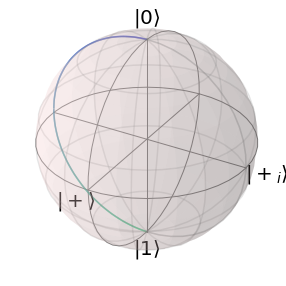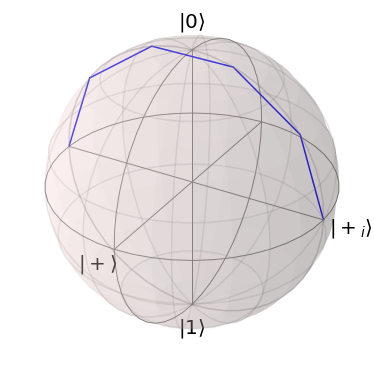1.2. Solver
The evolution of quantum mechanical systems is described by differential equations like Schroedinger’s equation and the Solver class and derived classes simulate these systems by solving the corresponding equation. They are the backbone of simulations in qopt. (In later sections, we will extend this procedure to stochastic differential equations and a master equation in Lindblad form, and discuss the corresponding solver classes.)
The class SchroedingerSolver computes the solution to Schroedinger’s equation and is therefore used to describe basic quantum systems in the absence of noise. The equation is given as:
for any wavefunction \(\psi(t)\) and a time depended Hamiltonian \(H(t)\). Lets set \(\hbar = 1\) for simplicity. Then split the Hamilton operator in a drift and a control part
where the latter can be written as sum weighted by control amplitudes
The drift Hamiltonian describes dynamics that we know about but cannot control, while the control Hamiltonian describes the contributions which can be changed dynamically to manipulate the qubit.
As a simple example, we consider a single qubit under Rabi-driving in the rotating frame. Its Hamiltonian with XY-control has the simple form:
where \(\delta_\omega\) is the frequency detuning and \(A_x\) and \(A_y\) the driving amplitudes. (A derivation is given in the examples section of the documentation.) Then we can split the Hamilton operator:
We implement this hamiltonian in qopt by using the dense operator class, which encapsulates the representation of a matrix with the functionalities of an operator such as taking the hermitian conjugate, the trace, or calculating the spectral decomposition.
[1]:
import numpy as np
from qopt.matrix import DenseOperator
sigma_x = DenseOperator.pauli_x()
sigma_y = DenseOperator.pauli_y()
sigma_z = DenseOperator.pauli_z()
For computational feasibility, we make the assumption of piece wise constant control and initialize the time steps. (In general they do not need to be equidistant.)
[2]:
n_time_steps = 5
total_time = 1
time_steps = (total_time / n_time_steps) * np.ones((n_time_steps, ))
The control Hamiltonian is given as list of operators and has an entry for each term in the control Hamiltonian. The drift Hamiltonian can either be an empty list, if the system does not have any drift dynamics, or a list with an entry for each time step, or a list with a single operator. In the last case this operator will be used for every time step.
[3]:
delta_omega = 0
h_ctrl = [.5 * sigma_x, .5 * sigma_y]
h_drift = [delta_omega * .5 * sigma_z]
By setting \(\delta_\omega\) to zero, we require the driving to be exactly resonant. Then set the control amplitudes to values resulting in an \(X_\pi\)-Rotation.
[4]:
control_amplitudes = np.zeros((n_time_steps, len(h_ctrl)))
control_amplitudes[:, 0] = np.pi
Then we initialize a solver for Schroedinger’s equation, for the Hamiltonian defined above and set the optimization parameters to the Hamiltonian.
[5]:
import matplotlib.pyplot as plt
from qopt import *
solver = SchroedingerSolver(
h_drift=h_drift,
h_ctrl=h_ctrl,
tau=time_steps
)
solver.set_optimization_parameters(control_amplitudes)
The equation is solved automatically, when we access the propagators. The propagators for each time step can be requested with the property Solver.propagators.
[6]:
solver.propagators
[6]:
[DenseOperator with data:
array([[0.95105652+0.j , 0. -0.30901699j],
[0. -0.30901699j, 0.95105652+0.j ]]),
DenseOperator with data:
array([[0.95105652+0.j , 0. -0.30901699j],
[0. -0.30901699j, 0.95105652+0.j ]]),
DenseOperator with data:
array([[0.95105652+0.j , 0. -0.30901699j],
[0. -0.30901699j, 0.95105652+0.j ]]),
DenseOperator with data:
array([[0.95105652+0.j , 0. -0.30901699j],
[0. -0.30901699j, 0.95105652+0.j ]]),
DenseOperator with data:
array([[0.95105652+0.j , 0. -0.30901699j],
[0. -0.30901699j, 0.95105652+0.j ]])]
Furthermore, the total time evolution is calculated in the property Solver.forward_propagators and a backward pass for the efficient calculation of derivatives as presented in the GRAPE alogrithm can be accessed by the property Solver.reversed_propagators.
[7]:
print('Total unitary of the evolution: ')
print(solver.forward_propagators[-1].data)
Total unitary of the evolution:
[[0.0000000e+00+0.j 0.0000000e+00-1.j]
[0.0000000e+00-1.j 4.4408921e-16+0.j]]
For visualization, we can also plot the resulting trace on the Bloch sphere:
[8]:
solver.plot_bloch_sphere()
plt.show()

We can also use a plotting function from qopt.plotting to consider another initial state:
[9]:
initial_state=(1 / np.sqrt(2)) * DenseOperator(np.asarray([[1], [1j]]))
plot_bloch_vector_evolution(
forward_propagators=solver.forward_propagators,
initial_state=initial_state
)

This plotting function plots the actual propagators as calculated by the Solver. The method Solver.plot_bloch_sphere oversamples the pulse for a smoother plot.
We can also define an initial state in the Solver class.
[10]:
solver_initial_state = SchroedingerSolver(
h_drift=h_drift,
h_ctrl=h_ctrl,
tau=time_steps,
initial_state=(1 / np.sqrt(2)) * DenseOperator(np.asarray([[1], [1j]]))
)
solver_initial_state.set_optimization_parameters(control_amplitudes)
Now the property Solver.forward_propagators contains the propagated initial state.
[11]:
solver_initial_state.forward_propagators
[11]:
[DenseOperator with data:
array([[0.70710678+0.j ],
[0. +0.70710678j]]),
DenseOperator with data:
array([[0.89100652+0.j ],
[0. +0.4539905j]]),
DenseOperator with data:
array([[0.98768834+0.j ],
[0. +0.15643447j]]),
DenseOperator with data:
array([[0.98768834+0.j ],
[0. -0.15643447j]]),
DenseOperator with data:
array([[0.89100652+0.j ],
[0. -0.4539905j]]),
DenseOperator with data:
array([[0.70710678+0.j ],
[0. -0.70710678j]])]